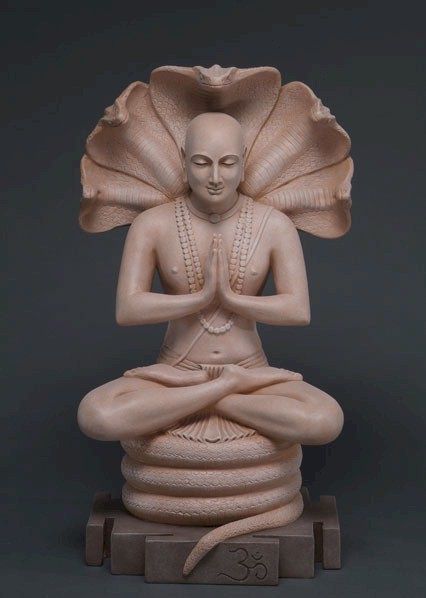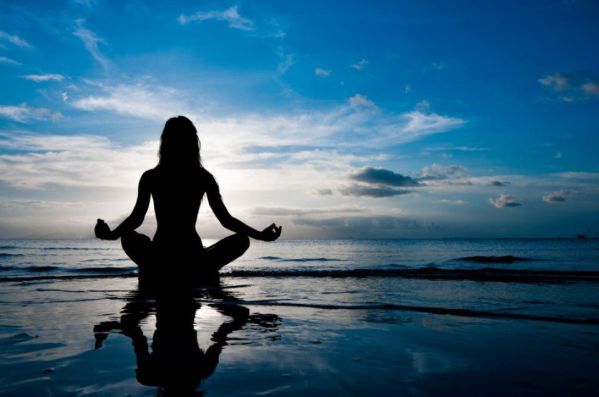No products in the cart.
‘Yoga’ -the very word radiates peace and tranquility. This feeling probably stems from the etymology of the word.
The word Yoga is derived from the Sanskrit word ‘Yuj’ which essentially means to join or unite. The union referred to is that of the individual self-uniting with Cosmic Consciousness or the Universal Spirit. Yoga is a means to achieving this goal.
Born in India, almost 26,000 years ago, Yoga is believed to have evolved during the period of the ‘Sat Yuga’, also called the Golden age. This period became known as a time of everlasting peace and abundant blessings, filled with seekers of the Eternal Truth. That is why, probably, even today we associate yoga with sages and hermits.
It was not until the discovery of the Indus- valley civilization, the largest civilization that knowledge about the origin of Yoga surfaced. Excavations give evidence of yoga’s existence during this period; yogi -like figures engraved on soapstone seals have been unearthed. In fact, it was the Aryans, migrating from the north- west, who were instrumental in discovering yoga.
Types of yoga
PATANJALI YOGA
 Patanjali is regarded as a divine incarnation of the serpent Anantha, who is revered as the ‘supporter of the whole universe’. He is the Adhisesha of Lord Mahavishnu.
Patanjali is regarded as a divine incarnation of the serpent Anantha, who is revered as the ‘supporter of the whole universe’. He is the Adhisesha of Lord Mahavishnu.
It is believed that on instructions from a great teacher, Patanjali identified all the teachings in the Vedas about the mind and presented them in a precise and organized form called ‘yoga’.
Patanjali’s yoga system aims to unite the individual self with the Supreme One. According to Patanjali, one can attain this union by controlling and eliminating the ever- arising ‘vrittis’ or modifications of the mind. He also suggests that the mind, in turn, can be controlled through the right kind of discipline and training.
Patanjali says that there are basic obstacles pervading the mind that are not conducive to yoga practice. He divides these obstacles into two groups:
1. Antarayas (intruders in the path of yoga)
2. Viksepasahabhuvah (co-existing with mental distraction)
There are nine Antarayas. They are:
1. Vyadhi (physical disease)
2. Styana (mental laziness)
3. Samsaya (doubt)
4. Pramada (heedlessness)
5. Alasya (physical laziness)
6. Avirati (detachment)
7. Bhrantidarsana (false perception)
8. Alabdha- bhumikatva (non-attainment of yogic states)
9. Anavasthitatva (falling away from yogic states attained)
Vyadhi means physical disease and is the first obstacle to the practice of yoga. If the body is inflicted with disease, it has to be cured and restored to a healthy state. Disease causes disturbance in the mind and makes it impossible to practice yoga or, for that matter, any other form of physical discipline.
Styana refers to mental laziness. This trait in the human psyche makes one desirous of the fruits of action without the required effort. Discrimination and will power should be cultivated to do away with mental laziness. Discrimination helps us to understand the benefits of yogic disciplines.
Samsaya means doubt. When one tries to control the mind, doubts arise. The mind does not know the benefits of concentration. Therefore, faith in oneself, the spiritual teacher and holy books is essential. Faith is necessary to dispel doubt.
Pramada means heedlessness. If one is heedless to cultivate virtues and follow truth, then the practice of yoga is not possible. Lack of vigil will lead to a steep fall in spiritual life.
Alasya or physical laziness (sloth) will attract ills like poverty. One should involve oneself in healthy activities to overcome such laziness.
Avirati refers to detachment. To practice yoga, the mind should be purified of material desires and a sense of detachment should be cultivated.
Bhrantidarsana or false perception leads to self-conceit. This trait is not good for anyone who is keen to practice yogic disciplines.
Alabdha bhumikatva means non-attainment of yogic states due to evil tendencies in our personality. These should be recognized and eliminated by dispassionate and deep introspection. Otherwise, progress is hindered.
Anavasthitatva means falling away from yogic states after reaching them. A person who has reached a lofty mental state can slide to a slow ruin, with just one base action. So, actions leading to a downfall have to be obliterated.
The Essence of Yoga
The true essence of Yoga revolves around elevating the life force or ‘Kundalini’ at the base of the spine. It aims to achieve this through a series of physical and mental exercises. At the physical level, the methods comprise various yoga postures or ‘asanas’ that aim to keep the body healthy. The mental techniques include breathing exercises or ‘pranayama’ and meditation or ‘dhyana’ to discipline the mind.
The ultimate goal of yoga is, however, to help the individual to transcend the self and attain enlightenment. As the Bhagavad-Gita says, “A person is said to have achieved yoga, the union with the Self, when the perfectly disciplined mind gets freedom from all desires, and becomes absorbed in the Self alone.”
Importance of Yoga
Yoga is not a religion; it is a way of living whose aim is ‘a healthy mind in a healthy body’.
Man is a physical, mental and spiritual being; yoga helps promote a balanced development of all the three. Other forms of physical exercises, like aerobics, assure only physical well-being. They have little to do with the development of the spiritual or astral body.
Yogic exercises recharge the body with cosmic energy this facilitates
- Attainment of perfect equilibrium and harmony
- Promotes self- healing.
- Removes negative blocks from the mind and toxins from the body
- Enhances Personal power
- Increases self-awareness
- Helps in attention focus and concentration, especially important for children
- Reduces stress and tension in the physical body by activating the parasympathetic nervous system
The aspirant feels rejuvenated and energized. Thus, Yoga bestows upon every aspirant the powers to control body and mind.
Benefits of Yoga
At the physical level, yoga and its cleansing practices have proven to be extremely effective for various disorders. To get a sampling of how yoga benefits health disorders, please visit the Yoga Therapy section.
More importantly, yoga is extremely effective in:
- Increasing Flexibility – yoga has positions that act upon the various joints of the body including those joints that are never really on the ‘radar screen’ let alone exercised.
- Increasing lubrication of the joints, ligaments and tendons – likewise, the well-researched yoga positions exercise the different tendons and ligaments of the body.
Surprisingly it has been found that the body which may have been quite rigid starts experiencing a remarkable flexibility in even those parts which have not been consciously work upon. Why? It is here that the remarkable research behind yoga positions proves its mettle. Seemingly unrelated “non strenuous” yoga positions act upon certain parts of the body in an interrelated manner. When done together, they work in harmony to create a situation where flexibility is attained relatively easily. - Massaging of ALL Organs of the Body – Yoga is perhaps the only form of activity which massages all the internal glands and organs of the body in a thorough manner, including those – such as the prostate – that hardly get externally stimulated during our entire lifetime. Yoga acts in a wholesome manner on the various body parts. This stimulation and massage of the organs in turn benefits us by keeping away disease and providing a forewarning at the first possible instance of a likely onset of disease or disorder.
- Complete Detoxification – By gently stretching muscles and joints as well as massaging the various organs, yoga ensures the optimum blood supply to various parts of the body. This helps in the flushing out of toxins from every nook and cranny as well as providing nourishment up to the last point. This leads to benefits such as delayed ageing, energy and a remarkable zest for life.
Excellent toning of the muscles – Muscles that have become flaccid, weak or sloths are stimulated repeatedly to shed excess flab and flaccidity.
But these enormous physical benefits are just a “side effect” of this powerful practice. What yoga does is harmonize the mind with the body and this results in real quantum benefits. It is now an open secret that the will of the mind has enabled people to achieve extraordinary physical feats, which proves beyond doubt the mind and body connection.
Yoga through meditation works remarkably to achieve this harmony and helps the mind work in sync with the body. How often do we find that we are unable to perform our activities properly and in a satisfying manner because of the confusions and conflicts in our mind weigh down heavily upon us? Moreover, stress which in reality is the #1 killer affecting all parts of our physical, endocrinal and emotional systems can be corrected through the wonderful yoga practice of meditation.
In fact yoga = meditation, because both work together in achieving the common goal of unity of mind, body and spirit – a state of eternal bliss.
The meditative practices through yoga help in achieving an emotional balance through detachment. What it means is that meditation creates conditions, where you are not affected by the happenings around you. This in turn creates a remarkable calmness and a positive outlook, which also has tremendous benefits on the physical health of the body.
These are just some of the tangible benefits that can be achieved through yoga.
Having seen this, it is educative to note why the ancient yogis performed yoga and the interdependence of yoga and meditation. The ultimate goal of the yogis was “self-realization” or “enlightenment”, a concept, which perhaps is quite esoteric to you and me.
But what is interesting is that for this they had to meditate for extensive spells of time – days, weeks and much more. This required tremendous physical fitness, energy and the capacity to subsist on next to nothing. Yoga positions or asanas provided them the fullest fitness with the least metabolism or stress and meditation in turn provided them the strength and will to perform these asanas effectively – a virtuous cycle of cause and effect. This mutually symbiotic relationship helped them in their path.







